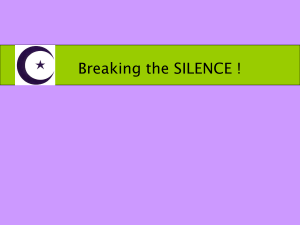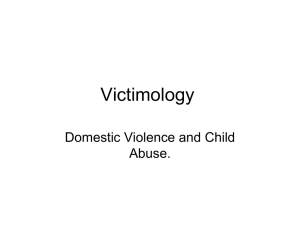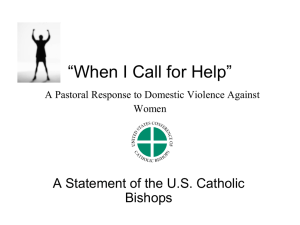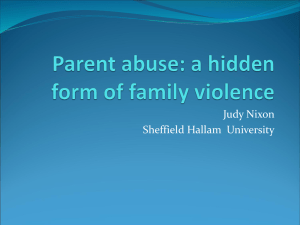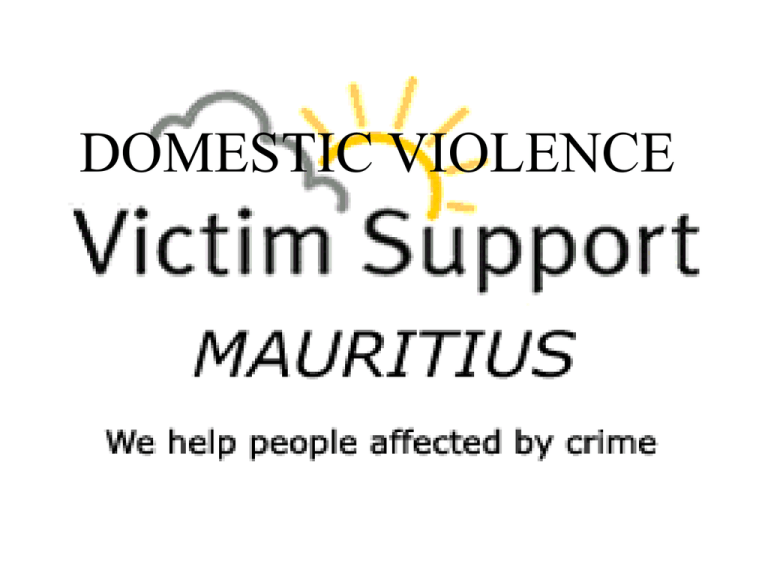
DOMESTIC VIOLENCE
UNDERSTANDING
CRIME PREVENTION
Une personne avertie en vaut Deux
Victims’ Rights
“Victim Support Mauritius exists to advance the
interests of people affected by crime and
encourage the development mechanisms of
support services throughout Mauritius and
Rodrigues, whilst motivated towards a crime
free society.”
“Suspects are innocent until proven guilty by a
court of justice whereas victims are guilty until
proven victim by the same court of justice.”
INDEX
•
•
•
•
•
•
•
•
•
•
Domestic Violence Introduction
What Is Domestic Violence?
Type of abuses
Risk Factors For Domestic Violence
Domestic Violence Signs and Symptoms
A Personalized Safety Plan
Safety in the Workplace
Determining Risk
Emergency Department
Victims Rights Proposals 2004
History
• To fully understand the roots of domestic violence in our
society, it is helpful to review some historical points.
Unfortunately, the abuse of women has been a part of
many cultures for many generations.
• British common law once allowed a man to “chastise” his
wife with “any reasonable instrument.”
• In the United States, throughout the 1800s, state laws and
cultural practices continued to support a man's right to
discipline his wife. In fact, it wasn't until 1895 that a
woman could even divorce her husband on grounds of
abuse.
• In 1994, the Violence Against Women Act was adopted.
This act encouraged research into domestic abuse and
generated the legal and financial support for law
enforcement and social services to protect battered women.
Domestic Violence Introduction
• Domestic violence is a well-known and often-used term.
Although it may describe various violent relationships,
such as child abuse, elder abuse, or abuse within a samesex relationship, it is most commonly applied to an
intimate relationship between a man and a woman in which
one partner (usually male) uses a pattern of assault and
intimidating acts to assert power and control over the other
partner (usually female).
• Only recently recognized as a major woman's health issue,
domestic violence has a long, dark past and is firmly
entrenched in many societies.
• Although domestic violence usually includes violent
attacks, it is not limited to physical acts of violence, but
may include psychological, economic, and sexual abuse as
well as attempts to isolate the partner.
What Is Domestic Violence?
• Domestic violence is most often a
relationship between a man and a woman in
which the male partner seeks to assert
power and control over the female partner.
Recently, more same-sex partners are now
affected and, rarely, women abuse men. The
abuser may use many different types of
abuse to assert this power, and the overall
framework in which the abuse occurs may
follow a pattern called the cycle of violence.
TYPE OF ABUSES
• Physical abuse (domestic violence)
• Verbal or nonverbal abuse (psychological
abuse, mental abuse, emotional abuse)
• Sexual abuse
• Stalking or cyberstalking
• Economic abuse or financial abuse
• Spiritual abuse
Physical abuse includes:
• Pushing, throwing, kicking
• Slapping, grabbing, hitting, punching, beating,
tripping, battering, bruising, choking, shaking
• Pinching, biting
• Holding, restraining, confinement
• Breaking bones
• Assault with a weapon such as a knife or gun
• Burning
• Murder
What is emotional abuse or verbal abuse
of a spouse?
• Mental, psychological, or emotional abuse can be
verbal or nonverbal. Verbal or nonverbal abuse of
a spouse or intimate partner consists of more
subtle actions or behaviors than physical abuse.
While physical abuse might seem worse, the scars
of verbal and emotional abuse are deep. Studies
show that verbal or nonverbal abuse can be much
more emotionally damaging than physical abuse.
What is sexual abuse or sexual
exploitation of a spouse?
Sexual abuse includes:
• sexual assault: forcing someone to participate in
unwanted, unsafe, or degrading sexual activity
• sexual harassment: ridiculing another person to try
to limit their sexuality or reproductive choices
• sexual exploitation (such as forcing someone to
look at pornography, or forcing someone to
participate in pornographic film-making)
• Marital rape, sodomy, incest etc.
What is stalking?
• Stalking is harassment of or threatening another person,
especially in a way that haunts the person physically or
emotionally in a repetitive and devious manner. Stalking of
an intimate partner can take place during the relationship,
with intense monitoring of the partner’s activities. Or
stalking can take place after a partner or spouse has left the
relationship. The stalker may be trying to get their partner
back, or they may wish to harm their partner as
punishment for their departure. Regardless of the fine
details, the victim fears for their safety.
• Stalking can take place at or near the victim’s home, near
or in their workplace, on the way to the store or another
destination, or on the Internet (cyberstalking). Stalking can
be on the phone, in person, or online. Stalkers may never
show their face, or they may be everywhere, in person.
What is cyberstalking?
• Cyberstalking is the use of
telecommunication technologies such as the
Internet, mobile or email to stalk another
person. Cyberstalking may be an additional
form of stalking, or it may be the only
method the abuser employs. Cyberstalking
is deliberate, persistent, and personal.
How likely it is that stalking will
turn into violence?
• Stalking can end in violence whether or not the
stalker threatens violence. And stalking can turn
into violence even if the stalker has no history of
violence.
• Women stalkers are just as likely to become
violent as are male stalkers.
• Those around the stalking victim are also in
danger of being hurt. For instance, a parent,
spouse, or bodyguard who makes the stalking
victim unattainable may be hurt or killed as the
stalker pursues the stalking victim.
What is economic or financial
abuse of a spouse?
• Economic or financial abuse includes:
• withholding economic resources such as money or
credit cards
• stealing from or defrauding a partner of money or
assets
• exploiting the intimate partner’s resources for
personal gain
• withholding physical resources such as food,
clothes, necessary medications, or shelter from a
partner
• preventing the spouse or intimate partner from
working or choosing an occupation
What is spiritual abuse of a spouse?
Spiritual abuse includes:
• using the spouse’s or intimate partner’s religious
or spiritual beliefs to manipulate them
• preventing the partner from practicing their
religious or spiritual beliefs
• ridiculing the other person’s religious or spiritual
beliefs
• forcing the children to be reared in a faith that the
partner has not agreed to
What are the causes of domestic
abuse or domestic violence?
• A strong predictor of domestic violence in adulthood is
domestic violence in the household in which the person
was reared. For instance, a child’s exposure to their
father’s abuse of their mother is the strongest risk factor
for transmitting domestic violence from one generation to
the next. This cycle of domestic violence is difficult to
break because parents have presented violence as the norm.
• Individuals living with domestic violence in their
households have learned that violence and mistreatment
are the way to vent anger. Someone resorts to physical
violence because
-They have solved their problems in the past with violence,
-They have effectively exerted control and power over others
through violence, and
-No one has stopped them from being violent in the past.
How does society perpetuate domestic abuse?
• Society contributes to domestic violence by not taking it
seriously enough and by treating it as expected, normal, or
deserved. Specifically, society perpetuates domestic abuse
in the following ways.
• Police may not treat domestic abuse as a crime, but, rather,
as a “domestic dispute”
• Courts may not award severe consequences, such as
imprisonment or economic sanctions
• A community usually doesn’t banish domestic abusers
• Clergy or counselors may have the attitude that the
relationship needs to be improved and that the relationship
can work, given more time and effort
• People may have the attitude that the abuse is the fault of
the victim, or that the abuse is a normal part of marriage or
domestic partnerships
• Gender-role socialization and stereotypes ignore abusive
behaviour by men
Who abuses their spouse or
intimate partner?
• Domestic abuse knows no age or ethnic
boundaries.
• Domestic abuse can occur during a relationship or
after a relationship has ended.
• Most psychological, medical, and legal experts
agree that the vast majority of physical abusers are
men. However, women can also be the
perpetrators of domestic violence.
• The majority of stalkers are also men stalking
women. But stalkers can also be women stalking
men, men stalking men, or women stalking
women.
What are the results of domestic
violence or abuse?
• The results of domestic violence or abuse can be very
long-lasting. People who are abused by a spouse or
intimate partner may develop:
• sleeping problems
• depression
• anxiety attacks
• low self-esteem
• lack of trust in others
• feelings of abandonment
• anger
• sensitivity to rejection
• diminished mental and physical health
What is the effect of domestic violence
on children?
• Children who witness domestic violence may develop serious emotional,
behavioural, developmental, or academic problems. As children, they may
become violent themselves, or withdraw. Some act out at home or school;
others try to be the perfect child. Children from violent homes may become
depressed and have low self-esteem.
• As they develop, children and teens who grow up with domestic violence in
the household are
• more likely to use violence at school or in the community in response to
perceived threats
• more likely to attempt suicide
• more likely to use drugs
• more likely to commit crimes, especially sexual assault
• more likely to use violence to enhance their reputation and self-esteem
• more likely to become abusers in their own relationships later in life
Take this quiz to assess your relationship
Has your partner ever...
-Destroyed your property (photos, jewelry, furniture)?
-Used or threatened use of a weapon?
-Called you stupid, crazy, worthless, etc.?
-Accused you of infidelity?
-Prevented you from seeing or talking to friends or relatives?
-Told you that violence is your fault or is caused by your actions?
-Threaten suicide?
-Forced you to perform any sexual act against your will?
If you answered yes to two or more of these questions,
you may ---be in danger of becoming, or have already
become, a victim of domestic violence. You may want to
believe that your partner really isn’t to blame and that
your problems will go away on their own, but this isn’t
true.
Domestic Violence Signs and Symptoms
• Domestic violence may lead to both physical and
psychological signs and symptoms in the woman.
Women may have obvious physical signs of
traumatic injury, but they may also complain of
non injury signs and symptoms, such as chronic
abdominal pain, that may seem unrelated to an
abusive relationship. Family and friends, even
coworkers, may see the following signs and
symptoms. You may recognize some of them if
you are a survivor of domestic violence. These are
also signs that doctors look for in assessing
potential victims of domestic abuse.
•
•
•
•
•
•
•
In my workplace, what are the warning signs that a
person is a victim of domestic violence?
Domestic violence often plays out in the workplace. For
instance, a husband, wife, girlfriend, or boyfriend might
make threatening phone calls to their intimate partner or
ex-partner. Or the worker may show injuries from physical
abuse at home.
If you witness a cluster of the following warning signs in
the workplace, you can reasonably suspect domestic abuse:
Bruises and other signs of impact on the skin, with the
excuse of “accidents”
Depression, crying
Frequent and sudden absences
Frequent lateness
Frequent, harassing phone calls to the person while they
are at work
Who abuses their spouse or intimate
partner?
• Domestic abuse knows no age or ethnic
boundaries.
• Domestic abuse can occur during a relationship or
after a relationship has ended.
• Most psychological, medical, and legal experts
agree that the vast majority of physical abusers are
men. However, women can also be the
perpetrators of domestic violence.
• The majority of stalkers are also men stalking
women. But stalkers can also be women stalking
men, men stalking men, or women stalking
women.
Risk Factors For Domestic Violence
• A number of studies have looked into identifying
women most at risk for domestic violence. The
most common feature is an imbalance of power
and control. However, neither women who
experience domestic violence nor the partners who
abuse them fall into distinct categories. They can
be of any age, ethnicity, income level, or level of
education. Following are examples of situations
that are common among women who experience
domestic violence. It is important to understand
that any woman can be abused.
Women at risk
– Planning to leave or has recently left an abusive
relationship
– Previously in an abusive relationship
– Poverty or poor living situations
– Unemployed
– Physical or mental disability
– Recently separated or divorced
– Isolated socially from family and friends
– Abused as a child
– Pregnancy, especially if unplanned
– Younger than 30 years
– Stalked by partner
A Personalized Safety Plan
• If an acute episode of domestic violence occurs in the
home, first assess your immediate safety.
• The question of when to obtain immediate assistance from
the local law enforcement agency must be based on your
belief that there is risk of bodily injury or death.
• If you believe that you or others in the home are in
immediate danger, call 999 – 208 0034/5 or 670 4815
• If possible you should attempt to do this without the
abuser’s knowledge, because this could lead to an
escalation of the violence.
• If you are currently in an abusive relationship, make plans
to ensure both you and your children's safety in the event
of recurrent or escalating violence.
Safety plan if abuser currently lives with you
– If possible, avoid arguments in small rooms, rooms
without easily accessible exits, or in rooms with access
to weapons (such as the kitchen).
– Avoid the use of alcohol and other mind-altering
substances because they may impair the your ability to
protect yourself and your children.
– Plan which doors and windows may provide quick exit
routes if immediate escape is necessary. Also, plan a
meeting place outside of the home.
– If possible, tell a reliable friend or neighbor to notify
law enforcement if they hear anything suspicious
coming from your home or over the telephone.
Safety plan if abuser does not live in
your home
– Change door and window locks.
– If possible, install safety devices (extra locks,
window bars, outdoor lights, motion detectors,
security system).
– Change phone number
– Inform neighbours or a closed one
– Inform nearest police station
Cycle of violence
Cycle of violence: Violent events may occur
in a variety of patterns—the woman may
experience ongoing, nonstop abuse, or the
abuse may stop and start. One pattern of
abuse often seen in a violent relationship
begins with a tension-building phase,
followed by the actual abusive act, and then
a calm, making-up phase often called the
honeymoon phase.
DOMESTIC VIOLENCE
•
Phase 1: Tension Building
This phase is composed of many minor
incidents of abuse, including jealousy,
tantrums, controlling behaviors, verbal
abuse, threats of violence, etc., that
gradually increase in severity.
•
Phase 2: Violent Incident
This phase is characterized by explosive and
uncontrollable rage.
•
Phase 3: Honeymoon Stage
This phase is characterized as calm with the
batterer exhibiting kind, loving behavior
towards his partner. He knows he has
overreacted; he is very sorry; and, he
wishes to redeem himself. Since the
tension is gone, he asks for forgiveness.
•
Resolutions
There is a way out. Since violence is a
learned behavior, it can be unlearned.
Counseling can teach the batterer
appropriate responses to anger and
frustration. Treatment can make possible
a peaceful and loving family life for the
batterer as well as for the abused woman
and the children.
PHYSICAL ABUSE
•
Intimidation
Putting a victim in fear by using looks, actions,
gestures, loud voice, smashing things,
destroying property.
•
Isolation
Controlling what a victim does, who the victim sees
and talks to, where the victim goes.
•
Emotional Abuse
Putting a victim down or making a victim feel badly
about themselves; name-calling; making victims
think they are crazy.
•
Economic Abuse
Trying to keep a victim from getting or keeping a job;
making the victim ask the abuser for money;
giving the victim an allowance.
•
Sexual Abuse
Making a victim do sexual things against their will;
physically attacking the sexual parts of the body;
treating the victim as a sex object.
•
Using Children
Making a victim feel guilty about the children; using
the children to give messages; using visitation
as a way to harass victim.
•
Threats
Making and/or carrying out threats to do something to
hurt victim emotionally; threatening to take the
children, commit suicide, or report victim to
welfare.
•
Using Male Privilege
Rigid sexual roles; women as subservient, males as
"Master of the Castle.“
NON - VIOLENCE
•
Economic Partnership
When partners make money decisions together.
Making sure both partners benefit from financial
arrangements.
•
Negotiation and Fairness
When partners seek mutually satisfying resolutions to
conflict, accept changes, and are willing to
compromise.
•
Non-Threatening Behavior
Talking and acting so that she feels comfortable
expressing herself and doing things.
•
Respect
Making sure to listen to your partner, without being
judgmental, being emotionally supportive and
valuing your partner's opinion.
•
Trust and Support
Supporting your partner's goals in life, respecting their
right to their own feelings, friends, activities and
opinions.
•
Honesty and Accountability
Accountability and responsibility for yourself,
acknowledge past use of violence, admitting
being wrong, communicating openly and
truthfully.
•
Responsible Parenting
Sharing parental responsibilities, being a positive,
non-violent role model for the children.
•
Shared Responsibility
Mutually agreeing on a fair distribution of work,
making family decisions together.
Victims’ Rights Proposal 2004
• Advertise a Victims Charter in Police station, courts etc.
• Victims Compensations Scheme
• Victims / Witness Security Requirements throughout
court process
• Free Legal Assistance for some Victims of crime
• Bereaved Family Financial Assistance
• Offenders Family Financial Assistance
• Free/guided court visit for victim/witness
• Reward to public crime discloser
• Camera process for victims of sexual abuse
• Camera in specific risky zones
• Victim support scheme in all courts
• Police Officers Rights
Victims’ Rights Proposal 2004 cont….
• Rights on information about criminal
investigation, prosecution and imprisonment
• Review the bail proceedings
• Review the issues of Protection orders
• Amend false and malicious allegation act
• Review imprisonment mode for juvenile offenders
• Segregation of offenders
• Juvenile courts
• Family courts
• Cosy desk for Victims of crime in
all Police Stations
• Regular S.W.O.T Analysis for Police officers as
well as Prison officers
• Auxiliary Police – Prospective recruits (aspirant)
We need your comments and
proposals to help the society.
Your comments will be piled
up after all Lectures.
We maintain confidentiality
from your points of view
If you want to have a copy of our
presentations. Please mail us or……
Victim Support Operation hours
Mon – Fri 10hr00 – 18hr00
Saturdays – 12hr00 – 15hr00
THANK YOU FOR YOUR KIND ATTENTION.
Presented by Raj Moothoosamy
President / Founder
Contact Details
Supportline (230) 670-4815
Fax (230) 670-5224
E-mail victimsupport@intnet.mu
r_moo@yahoo.com
Seat Address: Pope-Hennessy Street TerreCoupée Curepipe
Postal Address: P.o. Box 211 Curepipe
Republic of Mauritius
VICTIM SUPPORT MAURITIUS
2006




